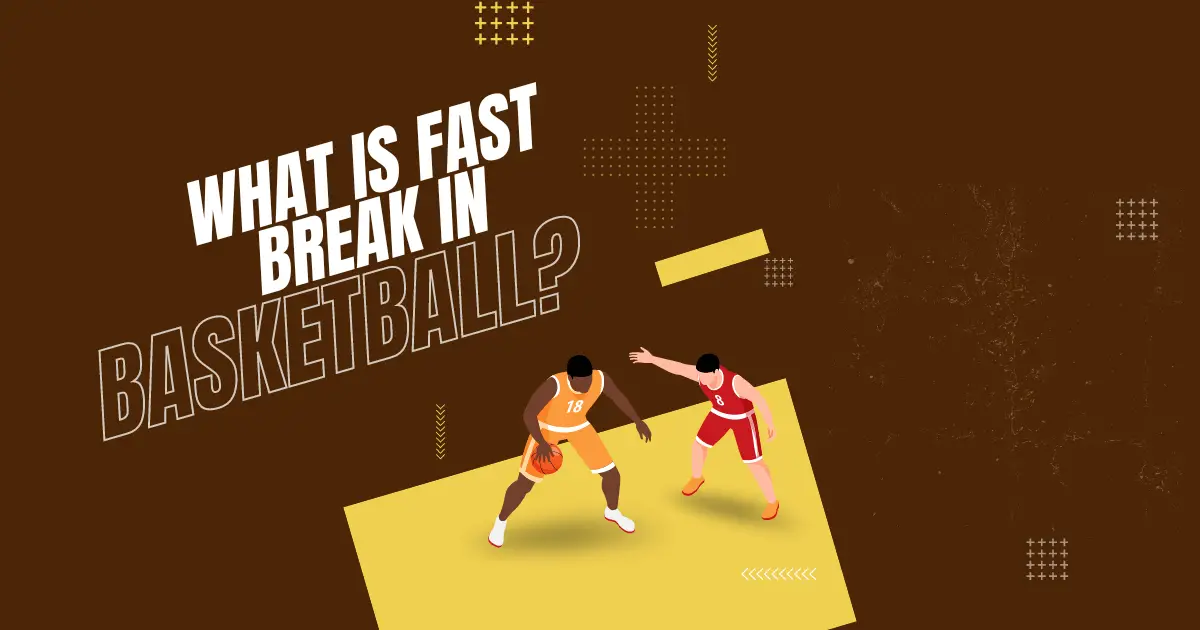Fast break in basketball definition:
Fast break or pass break in basketball is a highly important concept used by teams to gain increased control over the game. It involves quickly transitioning from defense to offense, usually after obtaining possession of the ball. This can be done to score points or regain control of the court. The fast break aims to take advantage of unsettled defenders who cannot set up proper defensive positions and strategies.
In a fast break, players must be able to move swiftly while maintaining possession of the ball for it to be successful. It relies heavily on accurate passing between teammates and quick decision-making as they advance down the court with the ball toward their opponent’s goal.
Why Should You Fast Break?
To Get Easy Scoring:

By running off missed shots, you allow yourself to score quickly before the defense can set up in transition – giving you easy buckets immediately.
Control Tempo:

Fast-breaking helps you control the game’s tempo. This can help prevent your opponents from playing at their preferred pace and making them uncomfortable on offense.
Force Bad Decisions On Your Opposition:

When executed properly, it will put immense pressure on the defense, forcing them into quick decision-making, which could lead to mistakes resulting in fouls or turnovers, which are beneficial to your offensive attack.
Offensive Rebounds

The fast break allows players to get down the court quicker and into better rebounding positions before their opponents react. This gives them a greater opportunity of snatching up those valuable offensive rebounds.
Types Of Fast Breaks:
Primary Fast Break:

The primary fast break is when the team has possession of the ball at their side of the court, typically after a rebound or steal situation. Players make quick passes upcourt while two players run into offensive positions, with one player filling in as a trailer.
Secondary Fast Break:

The secondary fast break occurs when there isn’t enough time to make a long pass upcourt and requires more movement by the players off-the-ball instead of just relying on passing upcourt.
The Numbered
The Numbered Fast Break involves assigning each player a number and position on the court that corresponds with their assigned number. For example, Player 1 would be located at the top of the key; Player 2 would be on the right side near midcourt, and so on. After gaining possession of the ball, players will move according to their assigned number, allowing them to transition into offense quickly. At the same time, their out-pacing defenders may not have had time to get back in position yet.
Motion Break
Motion fast breaks involve a team running an offensive play that the coach has pre-determined and choreographed. It requires all five players to move in unison and much practice and repetition to succeed.
How To Run A Fast Break?
Recognizing when you can successfully transition from defense to offense is essential. An open court ahead of you is key – look for defenders who are caught out of position or that you can outrun to advance the ball forward quickly. When taking off with the ball, stay low and keep it close – dribble with two hands if possible to maximize the speed and control of the ball.
Once in transition, don’t hesitate to decide whether you should continue upcourt or pass the ball off to one of your teammates. If you’re running down the court with a defender in front of you, be prepared to pass it off. If you can outrun them, go ahead and take the ball yourself.
When Not To Run A Fast Break?
If there aren’t enough offensive players or defenders clogging up passing lanes, attempting a fast break could lead to turnovers or missed shots.
Keys To Running A Successful Fast Break:
Develop A Tough Defense:
It is important to have an effective defense that creates turnovers or traps opponents so teams can quickly transition into an offensive attack. Developing a defensive strategy that works for your team will help them establish control over games and set up more scoring opportunities in transition.
Decide Who Will Push The Ball:
Coaches must decide who will push the ball on the fast break. Having one designated player who pushes the ball at all times can be beneficial because it allows players to learn how to become comfortable with pushing in transition at all times.
Instill A Fast Break Mindset:
As with any play, it’s important to have a unified approach when running your fast break. Make sure that all players understand their roles and are willing to work together as one unit. Utilize practice drills where players learn how to quickly recognize which teammate should receive their pass, who should look for shots, and who needs to stay back for defense.
Passing Is Key:
Pass quickly and accurately as soon as your team gains possession of the ball so they can get ahead of their opponent’s defense before they have time to set up. Also, ensure your players understand where they need to be on the court so that passes can easily reach them.
Look For An Opportunity:
As soon as a team gains possession of the ball, they should look for an opportunity to initiate the attack by either attacking their own or passing ahead for a teammate. This helps create easy scoring chances, which will help lead to overall success.
Get the Ball Into the Paint:
Teams need to get the ball into the paint to create scoring opportunities. If a team can push the ball into the paint, they can draw defenders away from their hoop, opening up more lanes and passing options. This will also give them a chance at an easy layup or dunk if they can beat their opponents with speed downcourt.
Conclusion:
A fast break can be an effective offensive strategy when executed properly. It involves quickly transitioning from defense to offense with efficient passing and ball handling. Recognize when a team should transition into a fast break situation and how long they should stay in it for maximum success. When done correctly, this type of play can give teams an advantage over their opponents by pushing the tempo and creating easy scoring opportunities.

Clyde Jackson III is a basketball coach and the founder of GCBC Basketball, a basketball-related learning and informational website that focuses on helping young players develop their skills on and off the court. With over 15 years of coaching experience, Clyde has worked with players of all ages and skill levels, from beginners to professionals.















